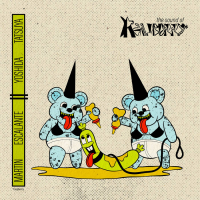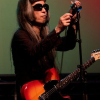Home »
Jazz Articles » Album Review » Tatsuya Yoshida / Martín Escalante: The Sound of Raspberry
This LP may be the revelation of 2025or a sonic ordeal, depending on your tolerance for noise and your grasp of history. Japanese drummer
”
data-original-title=”” title=””>Tatsuya Yoshida and Mexican saxophonist
Martín Escalante
saxophone, alto
”
data-original-title=”” title=””>Martín Escalante met at the perfect moment in December 2023 to record 14 tracks at Tokyo‘s Bar Aja. The result, The Sound of Raspberry, is the love child of punk rock and free jazz, fed through a grinder and pulverizer until nothing but raw nerve remains. The sound is head-spinning, in the same way Igor Stravinsky’s Rite of Spring provoked riots in 1913, or
Ornette Coleman
saxophone, alto
1930 – 2015
”
data-original-title=”” title=””>Ornette Coleman was assaulted and his horn smashed for daring to play music that reshaped the field.
Some context helps. In the 1980s, American saxophonist and composer
John Zorn
saxophone, alto
b.1953
”
data-original-title=”” title=””>John Zorn immersed himself in Japan’s underground avant scenea milieu where punk, prog, noise (or Japanoise) and free improvisation collided. Alongside the thriving cassette culture, Zorn spotlighted figures like ”
data-original-title=”” title=””>Masami Akita (Merzbow), Yamatsuka Eye,
”
data-original-title=”” title=””>Otomo Yoshihide and Ruins, through his work with the Japanese label Avant and his own Tzadik imprint. The resulting cross-pollination of New York’s downtown scene and Tokyo’s restless energy continues to resonate. Exhibit A: Yoshida and Escalante’s combustible partnership on The Sound of Raspberry.
Yoshida needs little introduction. He is a central figure in Japanese experimental music: founder of Ruins, collaborator with Zorn’s Painkiller, frequent partner to pianist
”
data-original-title=”” title=””>Satoko Fujii, and ally of improvisers like
Derek Bailey
guitar
1932 – 2005
”
data-original-title=”” title=””>Derek Bailey, Otomo Yoshihide and
”
data-original-title=”” title=””>Keiji Haino. His solo performances are legendary, built on blistering precision, impossible stamina and theatrical vocalizations.
Escalante, by contrast, is the wild card, though hardly an unknown. His reputation has been forged through digital releases, limited-run cassettes, 7″ singles and CDrs, echoing the DIY ethos of the pre-internet underground. His solo 2025 release Playing Harsh Noise on the Saxophone Since 2012 (Wash and Wear) demonstrates his endurance and intensity: recorded in Oita, Japan just a month before The Sound of Raspberry, it delivers a sweaty, room-clearing torrent of lung-busting eruptions. With no overdubs or effects, Escalante’s single performance evokes the ferocity of all three saxophonists,
Peter Brötzmann
woodwinds
1941 – 2023
”
data-original-title=”” title=””>Peter Brötzmann,
Evan Parker
saxophone, soprano
b.1944
”
data-original-title=”” title=””>Evan Parker and
Willem Breuker
saxophone
1944 – 2010
”
data-original-title=”” title=””>Willem Breuker on Machine Gun (BRÖ, 1968). The sheer physical stamina recalls the brutal catharsis of Black Flag in the 1980s.
Escalante’s discography in 2025 alone expands this vision. This Molten Salt (Wash and Wear), with drummer Charlie Mumma and bassist Teté Leguía, creates an unrelenting vortex of noise reminiscent of Borbetomagus. He also appears on the Norwegian duo Maranata’s Ugly Euphoria (Relative Pitch) and on An Inscrutable Bodily Discomforting Thing (Kettle Hole, 2025), alongside drummer ”
data-original-title=”” title=””>Jacob Felix Heule, bassist Leguía, and electronics artist ”
data-original-title=”” title=””>Danishta Rivero. Where Brötzmann,
Mats Gustafsson
woodwinds
b.1964
”
data-original-title=”” title=””>Mats Gustafsson,
”
data-original-title=”” title=””>Thurston Moore and even
Anthony Braxton
woodwinds
b.1945
”
data-original-title=”” title=””>Anthony Braxton have incorporated noise as a tool, Escalante makes it his foundation. The result is uncompromising. As Splatter Trio percussionist
”
data-original-title=”” title=””>Gino Robair once quipped, this is “bar-clearing music.” His earlier recording Soto (Sploosh, 2020), with Otomo Yoshihide, offers an instructive example. Escalante’s eight-minute solo “ME” is unrelenting: a physical and sonic gauntlet that drains both performer and listener, echoing the revolutionary shocks of Stravinsky and Coleman.
All of this history is prologue to Escalante’s meeting with Yoshida. The first nine tracks of The Sound of Raspberrymost under two minutesfind saxophonist and drummer locked in close combat. Escalante’s overblown upper-register screams and multiphonic assaults are met with Yoshida’s high-speed fusillades and punctuating vocalizations. The music surges forward in convulsions of energy, neither musician conceding ground, yet both completely in command of the chaos.
Side two (pressed, fittingly, on striking blue vinyl) contains five tracks that up the ante with the addition of electronics. Here, Yoshida and Escalante transform their already volatile exchanges into a broader spectrum of shrieks, roars, glitches and detonations. Electronics amplify Yoshida’s theatrical vocalizations, expanding the dialogue into a riotous, many-headed organism. The result feels like a mad joyride in a stolen car, barreling down a mountain road with no brakes, driven by the conviction that danger itself is the point.
What ultimately makes The Sound of Raspberry compelling is not just its extremity, but its clarity of intent. Yoshida and Escalante are not courting chaos for spectacle’s sake. They are placing themselves in a lineage that runs from the riots of The Rite of Spring to the smashed horns of Coleman, from Zorn’s downtown collisions to Merzbow’s annihilating walls of sound. This is music that insists on confrontation, demands stamina and rewards surrender. For those willing to take the ride, The Sound of Raspberry is a reminder that music’s most radical gestures are also its most enduring.
“>
Track Listing
Worldless Vocals; Six Simple Saxophones; Preeti Little Please Machine; Benign Tenticulations;
Soft Wear; Visual Product; Pierre Clementi In Belle De Jour; Without A Hat; Ruggerio Y Almendra;
The Sound Of Raspberrie; Nature’S Bottle Service; Besos Desde Las Lagunas Del Alto; It’S Time For
The Puppet Show!; [R̼̊].
Personnel
Additional Instrumentation
Tatsuya Yoshida: voice and electronics; Martín Escalante: voice.
Album information
Title: The Sound of Raspberry
| Year Released: 2025
| Record Label: Wash And Wear
Tags
PREVIOUS / NEXT
Support All About Jazz

All About Jazz has been a pillar of jazz since 1995, championing it as an art form and, more importantly, supporting the musicians who make it. Our enduring commitment has made “AAJ” one of the most culturally important websites of its kind, read by hundreds of thousands of fans, musicians and industry figures every month.
Go Ad Free!
To maintain our platform while developing new means to foster jazz discovery and connectivity, we need your help. You can become a sustaining member for as little as $20 and in return, we’ll immediately hide those pesky ads plus provide access to future articles for a full year. This winning combination vastly improves your AAJ experience and allow us to vigorously build on the pioneering work we first started in 1995. So enjoy an ad-free AAJ experience and help us remain a positive beacon for jazz by making a donation today.














